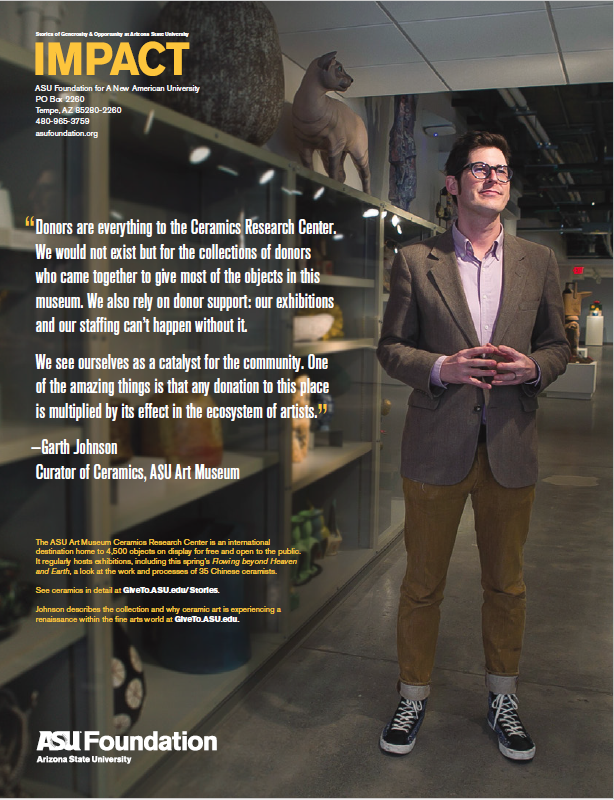Four Questions with Garth Johnson, Curator of Ceramics
The ASU Ceramics Research Center (CRC), part of ASU Art Museum, is located at street level in the Brickyard, just off Tempe’s Mill Avenue. Its 15th anniversary, being celebrated this March, marks a decade and a half of donor support and public engagement in a field that is “on fire” in the art market.
Here, Garth Johnson, curator of ceramics at the CRC, explains the collection.
How would you describe the collection at ASU’s Ceramics Research Center?
Our ceramics collection has about 4,500 objects in it. Our strength is post-World War I through present-day sculpture and pottery. One of the things we’re very proud of is that we exhibit about 700 pieces from our permanent collection in our open storage cabinets at any one moment, so any class that comes in to talk about any material, any artist or any movement is able to see the art directly in front of them.
Ceramic art relates to so many things: decorative art, interiors, homes, social function and fabric. One of the reasons the Ceramics Research Center is an important strength at ASU is because of the relationship between ceramics and almost everything in our lives.
What makes the Phoenix area a unique location to play host to the CRC?
This collection is special because the Phoenix area is not only a hotbed for artists coming and going, but many incredible collectors also have homes here and converge here.
It’s really interesting to be one of the hubs between artists, collectors, patrons, donors and the art world.
“We sold our business in 2007. Before that time, we’d been supporters of the ASU Art Museum and collectors of ceramic art. And then, I asked if there were any opportunities for volunteers at the CRC...and it’ll be ten years this April.”
What role does ceramics play in the contemporary art world?
Ceramics right now is enjoying a renaissance within the fine arts world.
The history of art is action and reaction. In a digital world, we see artists pushing back with very tactile materials.
There is renewed interest in the use of clay as a material: what it can do, what it means—and those are the conversations we’re having at the CRC, as well. This institution provides the scholarly depth as to why the art is important.
What role do donors have at the CRC?
Donors are everything to the Ceramics Research Center. We would not exist but for the collections of donors who came together to give most of the objects in this museum. We also rely on donor support: our exhibitions and our staffing can’t happen without it.
We see ourselves as a catalyst for the community. One of the amazing things is that any donation to this place is multiplied by its effect in the ecosystem of artists.





